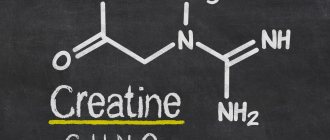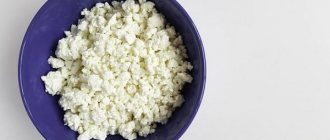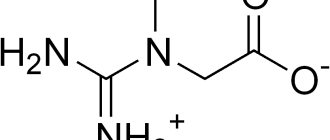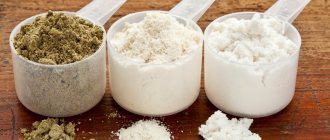Creatine has become one of the most popular sports nutrition supplements. Many studies have been conducted to determine safety, effectiveness and dosage for athletes, adults, children and older adults. And in this article we will look at how to take creatine correctly for maximum results.
The International Society of Sports Nutrition reports:
“(…) The most effective ergogenic nutritional supplements are currently available for athletes who increase their exercise intensity and want to build muscle mass. (…) Creatine monohydrate has been extensively studied and is considered a clinically effective form of creatine as a dietary supplement for building muscle mass and increasing the ability to handle intense exercise.”
Something needs to be cleared up. The most studied type of creatine is monohydrate. There are newer forms with improved properties. However, there is virtually no evidence that any of the new forms of creatine are more effective or safe than creatine monohydrate. This applies both when taken alone and in combination with other supplements. It is worth taking into account that the safety, effectiveness and regulatory status of monohydrate have been proven by numerous studies and personal experience of individual athletes. Other forms of creatine are less known and not as well studied.
Are you taking creatine? If you're into strength training, it should be part of your fitness supplement kit. The following are some reasons why:
- A good stimulant , increases strength, endurance and mobility. Helps withstand heavy loads and also prevents loss of strength during exercise.
- Improves the recovery process . Evidence shows that this supplement may reduce muscle damage and inflammation.
- Prevents damage . Some studies report that creatine supplements may reduce muscle damage, dehydration, and muscle cramps.
- Completes the rehabilitation process . Helps athletes and anyone else who takes this supplement when recovering from injuries.
When is the best time to take creatine?
There is a certain dosage, phases of use and interaction with organs, food and diseases. Therefore, we will first examine the basic concepts and then move on to dosages and administration schedule.
What is creatine?
It is a chemical compound formed by amino acids (the little building blocks that form protein). Located in muscle cells (95%) and brain (5%). Muscles use it as an energy resource. A certain amount of creatine accumulates in muscle tissue, which differs from person to person.
About 1-2% of creatine is excreted from the body in urine. To replenish and maintain creatine levels at normal levels, the body requires 1-3 g daily, depending on muscle mass. About half of the daily requirement can be obtained through a certain diet (red meat and seafood). The remaining amount is synthesized in the liver and kidneys. With a normal diet, which provides 1-2 g of creatine per day, the reserves of this substance in muscle tissue are about 60-80%.
Creatine - what is this substance?
Creatine is an acidic compound that plays a critical role in the energy metabolism of muscle and nerve cells. This is a classic representative of the ergogenic components of traditional sports nutrition.
Substances can be found in a wide variety of forms: from monohydrates to tricreatine malates. Creatine is especially widespread in bodybuilding. Its effect on increasing muscle mass is very noticeable, and its safety has been confirmed in numerous studies.
The role of creatine
During training, the body uses creatine as an available energy resource. To maintain and increase the effectiveness of exercise, the maximum amount of creatine reserves is required. Nutritional supplements help replenish the required amount.
When fully stored, muscles receive an immediate source of energy, resulting in increased strength, endurance and activity.
Post-workout creatine helps reduce inflammation, cramps, and prevent muscle tissue damage.
Because it retains water in the cells, muscles appear fuller. This has nothing to do with strength, but with water conservation. Please be careful. Strength requires training. Creatine is not a solution and will not help you get stronger without exercise.
Creatine and caffeine - compatibility[edit | edit code]
Correct mistake
The problem of the compatibility of creatine and caffeine has been discussed for several years, both in the scientific community and in the athletic community. Nowadays, the Internet is full of articles that recommend avoiding even coffee and tea while taking creatine, but many people don't even know why this debate is happening.
Previously, scientists and athletes believed that creatine and caffeine independently improved training performance and even had a synergistic effect, so combining them was quite popular in sports nutrition.
Creatine helps improve the function of the phosphocreatine system and ATP, and can also buffer lactic acid during exercise, while caffeine is a stimulant and indirectly activates the phosphogenic system. Thus, theoretically, both substances affect different parts of the training process and should help increase strength and muscle mass.
The history of the problem of compatibility between creatine and caffeine dates back to 1996, when a scientific study led by Vandenberghe K. showed that “caffeine reduces the loading process of creatine into muscle tissue.” Until now, almost all articles related to creatine and caffeine refer only to it. [1]
However, this conclusion has now been questioned because the experimental conditions (crossover design) were not fully suitable for testing the compatibility of caffeine and creatine. Cross-over studies do not allow assessment of the long-term effects of supplementation. For example, when subjects switched to a placebo, the effects of creatine remained for a long time, and this could completely change the results. In Vandenberghe K.'s study, only 3 weeks passed between taking placebo and a mixture of creatine and caffeine, although the minimum break should have been 5-6 weeks. [2]After a short period of time, Belgian scientists conducted another study with the same results, however, an erroneous protocol was used in this experiment.
Another important factor is diet. Creatine-rich foods can statistically significantly increase creatine loading rates. Thus, a group of people after taking creatine can maintain its high level for a long time if they take such food in abundance.
In addition, recent studies conducted without design errors have made it possible to refute the negative effect of caffeine on phosphocreatine levels and strength indicators. [3] The average body weight after taking creatine and caffeine, as well as creatine alone, remained approximately the same, but in the caffeine group, the mass fraction of muscle mass increased and the proportion of fat mass decreased.
Thus, all of the above facts suggest that the opinion about the negative effect of caffeine on creatine is not true. And if there are not yet enough facts to declare the effectiveness of the combination of caffeine and creatine, then the myth about the negative effects of caffeine can be considered destroyed. Athletes can drink coffee and tea while taking creatine, as well as take supplements containing small amounts of caffeine without compromising performance.
When is the best time to take creatine?
There are two stages to taking creatine:
Loading phase
At this stage (during the loading phase), creatine reserves in muscle tissue increase. The most effective way is to consume approximately 0.3 - 0.8 g per kg of body weight, 4 times a day, for 5-7 days.
For example:
If you weigh 70 kg, you need to consume at least 0.3 g per day.
70 x 0.3 = 21.
The daily norm is 21 g. This amount must be divided by four.
21 / 4 = 5,25.
5.25 gr at a time .
The amount per kg depends on the intensity of the workout, muscle mass and other factors. If your workout is intense, you will need 0.8 g per kg for the desired results.
Maintenance phase
It's about preserving supplies. Once the saturation phase is completed, you need to maintain the amount of creatine in the body by taking 3-5 g per day. Some studies suggest that heavier athletes should take 5-10 g/day.
The combination of these phases is the fastest method of increasing the amount of creatine in the body.
Creatine supplements allow you to gain weight quickly by retaining fluid in muscle cells. After this, you can train harder and more effectively.
Reception on rest days
Creatine intake after the loading phase remains the same (3 g per day), regardless of whether you train or not for 4-6 weeks. Next, you will have to take a break of at least 2 weeks so as not to have a negative impact on the body’s own production of creatine.
What does it contain?
What is the best way to drink creatine monohydrate - in powder or can it be obtained from food? Yes, this substance is found in some foods. Among them:
- tuna;
- herring;
- salmon;
- cod;
- beef;
- pork;
- milk;
- cranberry.
However, the percentage of creatine in these products is very small. For example, to get a daily dose of creatine, you need to drink 50 liters of milk per day. Naturally, this is unrealistic. Therefore, a synthetic drug is an excellent solution to this problem.
When is it better to take creatine - before or after meals? Many experts say that it is better to take this dietary supplement before meals. If taken after a meal, it may cause the food in the stomach to buffer the acidic environment, preventing the conversion of the substance from creatine to creatinine and causing insulin secretion.
It is noteworthy that creatine monohydrate is capable of only minor destruction when exposed to the acidic environment of the stomach. Therefore, in this case, there is not much difference in exactly when to take the nutritional supplement in this form.
What should you take with the supplement?
It is very important to choose the right time to take creatine and what you take it with. Eating a large amount of carbohydrates (about 70-100 g) with each meal increases the effect of creatine due to the stimulating effect of insulin. It is best to take supplements with a meal or with a carbohydrate-rich snack. In addition, this substance is useful to use not only during training, but also on rest days.
How and after how long to take creatine after training
Any strength training is stress for the body, which it is trying to cope with. For this reason, after training, the internal systems of the body work 2-3 times more powerful and active than usual. This period is optimal for taking creatine.
Reasons:
Learning to properly close the protein-carbohydrate window after training
- increased blood flow promotes rapid transport of nutrients in tissues;
- the body urgently needs energy replenishment to start muscle recovery processes;
- after an active load on the muscles, a “protein-carbohydrate window” is formed - a period of time when the body urgently needs simple carbohydrates and protein (protein foods). Using creatine with carbohydrate products will not only speed up the entire absorption process, but also make the result more noticeable.
How to take monohydrate powder: Take the supplement with juice (grape, orange, etc.) for better absorption.
This will allow you to get all the benefits for the body:
- replenishment of ATP reserves (filling with additional energy);
- creation of relief muscles;
- building muscle mass;
- natural energy exchange in muscle tissue;
- fast anabolic effect.
The optimal time to take the product is approximately 20-30 minutes after the end of the training , but not later than 1 hour. Compliance with this rule will allow you to get the maximum benefit from the supplement.
Important: when should you not take creatine supplements?
Pregnancy and breastfeeding: There is currently no reliable information about how safe it is for pregnant and breastfeeding mothers to take creatine.
Kidney and Liver Diseases: People suffering from kidney and liver diseases (such as kidney failure and hepatitis) should not use this dietary supplement as creatine may aggravate the condition.
Caffeine may reduce the beneficial effects of creatine.
Effect on the body
On the sports nutrition market now you can count about twenty different types of the drug from different manufacturers. But before you start taking this sports supplement, you should understand in more detail its effects on the body.
Positive
The benefits are as follows:
- rapid gain of muscle mass;
- increase in strength;
- saturating cells with “energy”;
- formation of beautiful muscle relief;
- increased production of testosterone and somatotropin;
- preventing the development of ischemia by supplying tissues with oxygen;
- increased performance.
Negative
It has been proven that taking the supplement is not harmful. However, it may be accompanied by some negative phenomena. Side effects of creatine appear as:
- swelling;
- dehydration;
- disorders of the digestive system;
- seizures
Contraindications
This is a synthetic drug. We have already mentioned what side effects creatine monohydrate has. It also has some contraindications that you should be aware of:
- bronchial asthma;
- pathologies of internal organs;
- pregnancy and breastfeeding period.
Briefly about the effects of creatine
The most basic effect for which creatine is so valued by bodybuilders is to increase strength potential. It is not surprising that combining creatine and caffeine, at first glance, can charge the body with vigor and energy. But in reality it's not that simple.
Be sure to read: What is the difference between the drugs Reduslim and Reduxin? Advantages and disadvantages
It is worth noting other pronounced effects of this substance:
- Increased muscle mass;
- Improving the quality of muscle tissue;
- Stimulation of the secretion of anabolic hormones;
- Release of lactic acid fragments during intense muscle work;
- Improving the overall blood picture (neutralization of “bad” cholesterol fractions);
- Anti-inflammatory effect (noticeable when there is local irritation of tissues or foci with chronic inflammatory processes in the body);
- Protection of central nervous system structures during ischemic attacks and in conditions of mild or moderate hypoxia.
Biological functionality of the substance
Creatine is a natural compound found in muscle fibers of the human body as well as animals. The main function is to provide muscles with energy. On average, tissues accumulate up to 150 grams of this substance.
Creatine plays such an important role for health and beauty as proteins, fats and carbohydrates or vitamin fractions with mineral compounds. The human body is capable of independently synthesizing creatine using three amino acids as “raw materials”:
- Glycine;
- Arginine;
- Methionine.
Creatine reserves are concentrated in the muscles. They are consumed relatively slowly, but with increasing physical activity, the amount of acid fractions can sharply decrease. To remain energetic and able to work, it is important to adhere to a specific diet and ensure that the body has the resources to produce “native” creatine.











